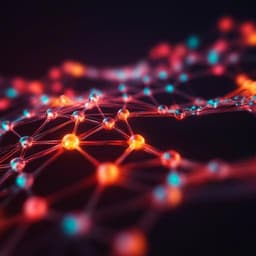
Psychology
The genetic determinants of language network dysconnectivity in drug-naïve early stage schizophrenia
J. Du, L. Palaniyappan, et al.
This groundbreaking study by Jingnan Du, Lena Palaniyappan, and colleagues reveals the intricate language network dysconnectivity in early-stage schizophrenia, linking it to illness duration and genetic factors. A significant finding is the connection between polygenic risk scores related to FOXP2 genes and dysconnectivity in patients with shorter illness duration, emphasizing the critical nature of language processing in mental health.
~3 min • Beginner • English
Introduction
The study addresses whether dysconnectivity of language-related brain networks is a primary feature in the earliest, untreated stages of schizophrenia and whether language-related genetic variants (notably FOXP2-related gene assemblies) contribute to this dysconnectivity. Schizophrenia shows variable progression and is influenced by treatment; thus, examining drug-naïve first-episode schizophrenia (FES) across a wide range of illness duration enables probing early mechanistic alterations. Prior work indicates early functional connectivity abnormalities and links between schizophrenia and language dysfunction, but the contribution of language genes to early network dysconnectivity remains unclear. The authors hypothesize that: (1) early-stage FES shows prominent dysconnectivity of language networks (e.g., Broca’s area), which changes with illness duration; and (2) pathway-specific polygenic risk from language-related genes is more strongly associated with dysconnectivity in the early (short-duration) than later (long-duration) stages of untreated illness.
Literature Review
The introduction situates schizophrenia as a disorder with demonstrated brain changes that may progress in some patients, but not universally. Early illness years are prognostically critical, and functional connectivity abnormalities in the first two years have been highlighted. Familial risk is substantial, yet the specific brain networks mediating genetic risk are unclear, particularly given that dysconnectivity patterns evolve with illness course and treatment. Language dysfunction is a core and early feature of schizophrenia, and theoretical accounts (e.g., Crow’s linguistic primacy hypothesis) propose a close etiological relationship between schizophrenia and language. The literature has identified genes implicated in both language readiness and schizophrenia (e.g., FOXP2 and related pathways), supporting exploring biologically informed, pathway-specific polygenic risk in imaging-genetics to bridge genetic variation and dysconnectivity phenotypes.
Methodology
Design and participants: Two independent cohorts of Mandarin-speaking Han Chinese were recruited at Shanghai Mental Health Center (2016–2018). Discovery (primary) dataset: 138 drug-naïve FES patients and 112 healthy controls (HC); 107 patients and 71 HC had whole-exome sequencing (WES). Validation dataset: 53 FES and 56 HC after motion exclusion (mean framewise displacement > 0.5 mm). FES diagnosis followed DSM-IV; all participants were right-handed, age 14–45, and free of neurological disease, substance abuse, or MRI contraindications. Symptom severity used PANSS. Illness duration (DUP) ranged 1–100 weeks; FES defined as illness duration < 2 years. For duration analyses, the primary FES sample was split at the median 23.3 weeks: short (n=69; mean 11.2 weeks) and long (n=69; mean 48.6 weeks). Imaging acquisition: Resting-state fMRI on 3T Siemens, 8 min, 240 volumes, TR/TE=2000/30 ms, flip angle 77°, matrix 64×64, voxel 3×3×3 mm³, 50 slices, FOV 220×220 mm². Preprocessing: FSL and AFNI were used. Slice-timing correction; motion correction (24 parameters); registration to 3 mm MNI space (via T1); spatial smoothing with 6 mm FWHM; wavelet despiking; band-pass 0.01–0.1 Hz; regression of white matter, CSF, and global signals; subjects with mean framewise displacement > 0.5 mm excluded. Brain-wide voxel-level functional connectivity analysis (BWAS): Cerebrum masked by AAL2 atlas yielded 47,619 voxels. For each subject, Pearson correlations between all voxel pairs were Fisher z-transformed creating a 47,619×47,619 matrix. Group comparison (FES vs HC) via GLM with covariates (age, gender, education, mean framewise displacement) produced z-statistics per voxel-pair. Cluster-defining threshold (CDT) p=2×10^-8 (z=5.5) in the primary dataset; functional connectivity clusters (FC clusters) defined as sets of suprathreshold edges linking the same two spatially contiguous voxel clusters. Multiple comparisons controlled using cluster-size FWER via random field theory; FC clusters with FWER-corrected p<0.05 deemed significant. Cross-validation: For each significant FC cluster from the primary dataset, the mean of all constituent voxel-level connectivities was computed in the validation dataset to test case-control differences. Stage-specific analyses: Short- vs long-duration subgroups each compared separately with all HCs using cluster-level inference with CDT p=3×10^-8 (z=5) and cluster-size FWER p=0.05 (adjusted for smaller sample sizes). Symptom correlations: Partial correlations between FC cluster strength (mean within-cluster connectivity) and PANSS positive/negative scores using the same covariates; significance via 10,000 permutations and FDR correction. Genetics (WES and pathway-specific PRS): WES libraries prepared with SureSelectXT Human All Exon V6+UTR (Agilent) and sequenced on Illumina NovaSeq6000 (2×150). Variant calling used Sentieon pipeline (alignment to hg19, duplicate marking, indel realignment, BQSR, SNV/indel detection, VQSR). Candidate genes selection: From 42 genes implicated in both language readiness and schizophrenia (per Murphy & Benítez-Burraco), 20 genes with established roles in human brain development were selected via functional enrichment (ToppGene). These 20 genes were clustered by whole-brain expression profiles (Allen Brain Atlas; K-means) to identify a FOXP2-centered co-expression module (FOXP2 cluster genes: DLX1, ERBB4, FOXP2, MET, NRG3, ROBO2). From 88 SNPs within this 6-gene module, 20 SNPs associated with case-control status (p<0.05) in the sample were used to compute pathway-specific PRS (weighted sum using log(OR) weights). Associations between PRS and altered FCs were evaluated in 107 patients with both imaging and genetics: correlations computed separately for FCs identified in short-duration (4 clusters) and long-duration (29 clusters) groups; comparison of correlation strengths via t-test and non-parametric permutation (10,000 iterations) using the mean altered voxel-level FC per subject. Specificity analysis: Repeated PRS-FC correlations using SNPs from all 20 development-related genes (unfiltered by FOXP2 co-expression) to test specificity of the FOXP2 module.
Key Findings
- Case-control dysconnectivity: In the primary dataset, 5,925 voxel-level connections passed CDT p=2×10^-8 (z=5.5), forming 327 FC clusters; 33 largest FC clusters (comprising 4,365 of the 5,925 connections) survived cluster-size FWER p<0.05. These involved thalamus (bilateral), temporal cortex (middle/superior), inferior frontal gyrus (including Broca’s area), precuneus, and subcortical structures (pallidum). Ten clusters involved thalamus; the two largest linked bilateral thalamus with middle/superior temporal lobe. Five clusters linked left inferior frontal gyrus (triangular/orbital; Broca’s area) to anterior cingulate cortex (ACC), left medial superior frontal gyrus, putamen, and pallidum. - Replication: In the validation dataset, 16 of the 33 FC clusters were significantly altered in patients vs controls, primarily involving left inferior frontal triangular gyrus, bilateral thalamus, left middle temporal lobe, and right superior temporal lobe. - Symptom associations: FC between thalamus and superior/middle temporal gyrus, and between left IFG (Broca’s area) and right ACC, correlated with PANSS negative total scores. Examples (r, FDR p): Left thalamus–Right superior temporal gyrus r=0.304, FDR p=0.0165; Right thalamus–Left middle temporal gyrus r=0.237, FDR p=0.0469; Left IFG triangular–Right ACC r=0.226, FDR p=0.0469. Item-level analyses linked IFG–ACC connectivity with conceptual disorganization (positive symptom), emotional withdrawal, passive/apathetic social withdrawal, and difficulty in abstract thinking (negative symptoms). - Stage-specific patterns: Short-duration group (n=69; mean 11.2 weeks) showed 4 significant FC clusters (FWER p<0.05) mainly linking Broca’s area (left IFG triangular/orbital; including interhemispheric links) to precuneus and ACC contralaterally. Long-duration group (n=69; mean 48.6 weeks) showed 29 significant FC clusters (FWER p<0.05), predominantly involving bilateral thalamus, middle and superior temporal lobes, and IFG; 5 of the top 10 clusters involved thalamus. - Genetics and dysconnectivity: Of 88 SNPs in the 6 FOXP2-cluster genes (DLX1, ERBB4, FOXP2, MET, NRG3, ROBO2), 20 SNPs were associated with schizophrenia (p<0.05). Pathway-specific PRS derived from these SNPs showed stronger correlations with altered FCs identified in the short-duration group than those in the long-duration group (t(33)=1.87, p=0.036). A permutation test showed a significant correlation between PRS and mean altered voxel-level FCs in short-duration patients (n=1,375 FCs; p=0.049), but not in long-duration patients (n=13,233 FCs; p=0.716). Using unfiltered PRS from all 20 development-related genes reduced correlation magnitudes and yielded no significant associations in either group (mean r=0.069 short; 0.062 long), supporting specificity of the FOXP2 co-expression module. - Overall pattern: Increased resting-state functional connectivity involving Broca’s area and thalamus/temporal cortex characterizes drug-naïve FES, with Broca’s area–ACC dysconnectivity more prominent early and thalamo-temporal dysconnectivity predominant later.
Discussion
The findings support the hypothesis that language network dysconnectivity is a primary and early feature of schizophrenia. Drug-naïve FES patients demonstrated elevated connectivity involving inferior frontal gyrus (Broca’s area) and superior/middle temporal cortex (core language regions), replicated across two datasets. Early-stage patients (short duration) predominantly exhibited Broca’s area dysconnectivity, particularly with ACC, and these connectivity abnormalities related to negative symptom severity and disorganization-related features, underscoring the clinical relevance of language network dysfunction. With longer untreated duration, dysconnectivity prominently involved bilateral thalamus and temporal regions, consistent with thalamo-cortical alterations seen in more chronic stages. Imaging-genetic analyses bridged genetic variation and network phenotypes by demonstrating that a pathway-specific PRS from a FOXP2-centered, co-expressed gene module (implicated in language, brain development, and schizophrenia) was specifically associated with early-stage dysconnectivity, but not with later-stage patterns. This supports Crow’s linguistic primacy hypothesis by providing convergent neuroimaging and genetic evidence linking language-related genes to early dysconnectivity in schizophrenia. The stage-dependent dissociation suggests that initial genetic determinants influencing language network connectivity may be supplanted or masked by compensatory and chronicity-related processes (e.g., thalamo-temporal changes) as illness persists untreated. These insights emphasize the value of studying drug-naïve patients and parsing illness duration to clarify mechanisms and to inform prognostic and therapeutic strategies targeting language networks.
Conclusion
This study demonstrates that drug-naïve first-episode schizophrenia is characterized by increased functional connectivity within language-related networks (notably Broca’s area) and thalamo-temporal regions, with a clear stage-specific pattern: early illness shows Broca’s area–ACC dysconnectivity, whereas longer untreated duration shows widespread thalamic and temporal dysconnectivity. Importantly, pathway-specific polygenic risk from a FOXP2-centered, language- and development-related gene module is linked to early-stage dysconnectivity, providing mechanistic evidence for the linguistic primacy hypothesis in schizophrenia. The work bridges genetic variation, brain network dysconnectivity, and clinical symptomatology (negative symptoms and aspects of disorganization) in untreated early illness. Future directions include longitudinal imaging-genetics in untreated and early-treated cohorts to track trajectories from Broca’s-centric to thalamo-temporal dysconnectivity, integrating direct measures of language function and formal thought disorder, and testing targeted linguistic or network-based interventions to mitigate early pathophysiological processes.
Limitations
- Lack of direct behavioral or task-based measures of language impairment or formal thought disorder prevents attributing the observed dysconnectivity specifically to language performance deficits. - Findings should not be generalized to verbal performance/abilities, which were not assessed. - Cross-sectional design with stage stratification by duration cannot establish within-subject progression; longitudinal studies are needed. - Genetic analysis focused on an exome-based, pathway-specific PRS for a FOXP2-centered module; broader genomic contributions and non-genetic factors in later-stage dysconnectivity were not fully characterized. - Generalizability may be limited to Mandarin-speaking Han Chinese, drug-naïve FES samples.
Related Publications
Explore these studies to deepen your understanding of the subject.







